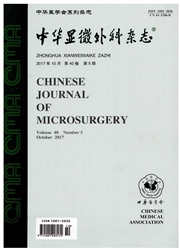

 中文摘要:
中文摘要:
目的探讨明胶海绵作为中枢神经组织1二程载体材料的可能性,为其作为神经干细胞的有效载体进行中枢神经移植奠定基础。方法体外培养胚胎14dSD大鼠端脑神经干细胞,将其分为可吸收明胶海绵组和对照组,观察两组神经干细胞的形态及其增殖情况;诱导分化后.利用免疫荧光技术观察两组神经干细胞分化情况。结果移植组和对照组形态和增殖未见明显异常,细胞存活率分别为91.6%与92.8%:神经干细胞可黏附于可吸收明胶海绵表面,诱导分化后的细胞呈现部分神经元细胞及神经胶质细胞的典型形态,并交织成网状结构,用细胞免疫荧光方法检测特异性异性烯醇酶(NSE)和神经胶质纤维酸性蛋白(GFAP)表达阳性。结论神经干细胞能够与可吸收明胶海绵良好混合培养,神经干细胞形态、增殖、分化未见明显异常,为进一步可吸收明胶海绵作为中枢神经系统组织工程的载体的研究奠定了理论基础。
 英文摘要:
英文摘要:
Objective To explore the possibility of gelatin sponge as supporter of central nervous tissue engineering. Methods Primary NSCs were isolated from forebrain of neonatal Sprague Dawley rats and cultured in serum-free medium for long-term survival in vitro. Neural stem ceils were divided into absorbable gelatin sponge group and control group. Observe their morphology and proliferation. Immunofluoreseence tech- nique were used to test the results of differentiation of two groups of neural stem ceils. Resultes NSCs in ab- sorbable gelatin sponge group and control group survived and there was no conspicuous change in shape and quality. The rates of survival cell were 91.6% and 92.8% respectively, which was no significant difference between them. NSCs could adherented to the surface of the gelatin sponge and well-grown. After induced dif- ferentiation, NSCs started to shrink and stretch, axons grown and connected with each other, till form net- work structure. The expression of neuroglia cell marker GFAP and neuron cell marker NSE could be detected by immunofluorescence assay. Couclusion Neural stem cells and gelatin sponge can mixed and cultivating together in vitro. NSCs is no conspicuous change. It is suggested that absorbable gelatin sponge can serve as the carrier of the tissue engineering of central nervous system.
 同期刊论文项目
同期刊论文项目
 同项目期刊论文
同项目期刊论文
 期刊信息
期刊信息
